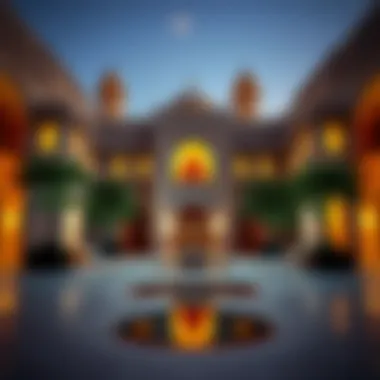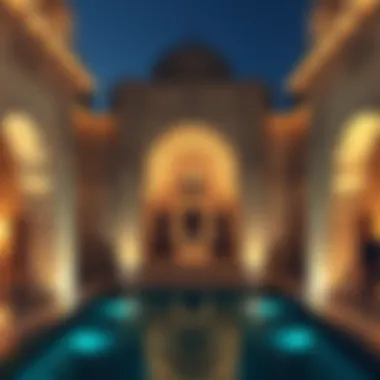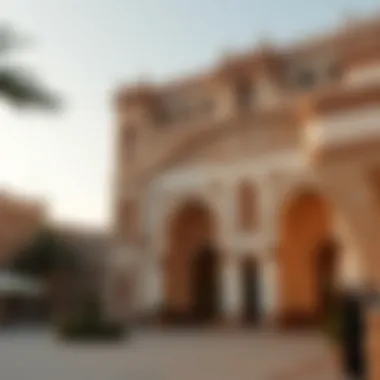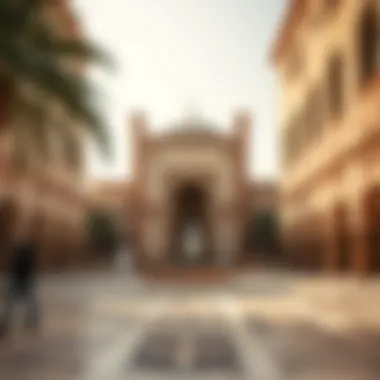Discovering Bayt Al Safa: A Cultural Landmark in Dubai


Intro
Bayt Al Safa stands as a significant cultural and historical landmark in the heart of Dubai. With its unique architectural design and fascinating backstory, this site offers local and international visitors a glimpse into the rich tapestry of the city’s heritage. Often overlooked amidst the fast-paced urban landscape, Bayt Al Safa is not just a structure; it embodies the spirit of the community and its journey through time. The intricacies of its design and the stories that fill its walls provide a vivid insight into the life of the Emirati people.
In this article, we will explore the importance of Bayt Al Safa, its architectural features, its role in the surrounding neighborhood, and the historical context surrounding its establishment. For those considering moving or investing in Dubai, we’ll also discuss practical advice on how to appreciate this significant site and its impact on the local community. Let's dive into the fascinating layers that make Bayt Al Safa a must-visit destination and a key point of reference for understanding Dubai's evolution.
Historical Context
Understanding the historical context of Bayt Al Safa is essential to appreciate its role in both Dubai's past and present. This landmark offers insights into the traditional ways of life that shaped the Emirati culture. Not merely a building, Bayt Al Safa embodies the essence of community, familial ties, and the architectural styles of its period.
The Origins of Bayt Al Safa
Bayt Al Safa's story begins in the mid-20th century when Dubai was transforming from a small coastal town into a bustling trade hub. Constructed around 1955, it served as a reminder of the simpler times before the oil boom. The house was built for a prominent family, signifying wealth but also a communal gathering spot, where stories and traditions were shared. This melding of domestic space with social interaction is intrinsic to Bahr Al Safa’s origin.
The architecture reflects traditional materials and construction methods, which were prevalent before the influx of modern building techniques. Locals frequently used coral stones and palm fronds. This choice of materials not only enhanced the durability of the structure but also forged a connection with the local environment and resources.
Key Figures in Its Development
Several influential figures played a pivotal role in developing Bayt Al Safa. Among them was Sheikh Mohammed bin Rashid Al Maktoum, the Vice President and Prime Minister of the UAE, who, while not directly involved in its construction, promoted the preservation of cultural heritage sites like Bayt Al Safa, emphasizing the importance of remembering one's roots amidst rapid modernization.
Moreover, local artisans and craftsmen contributed significantly to its design and construction. Their expertise in traditional building methods ensured that the essence of Emirati culture was preserved. By fostering a sense of pride in local craftsmanship, these individuals bolstered community bonds and encouraged knowledge transmission to future generations.
Milestones in Construction
The construction of Bayt Al Safa marked several significant milestones in Dubai’s architectural history. Initially, the project was a testament to the age-old practices of Emirati craftsmanship. However, as the years rolled on, the structure underwent various renovations to preserve its integrity against the forces of nature. For instance, in the 1980s, modern techniques were integrated to ensure the building remained relevant and could withstand the passage of time.
Over the decades, Bayt Al Safa has not only survived the physical shifts of Dubai’s urban landscape but has also adapted to the cultural shifts within the Emirati society. In the 1990s, it was repurposed to serve as a museum, showcasing the evolution of Dubai. This transformation represented a significant milestone, as it turned a private residence into a public resource, making it accessible to the international audience and underscoring its importance as a historical asset.
"Bayt Al Safa stands as a bridge between the desolate past and the vibrant present of Dubai, capturing the essence of cultural evolution."
By examining these elements collectively, one can better grasp the intricate weave of history surrounding Bayt Al Safa. It's a narrative not just of a building, but a reflection of the Emirati spirit that continues to thrive amid change.
Architectural Features
Bayt Al Safa serves not only as a historical entity but also as a testament to the architectural prowess of its era. The significance of architectural features cannot be overstated as they reflect cultural, social, and technological developments of a place. In the context of Dubai, which is often perceived as a city of modernity and skyscrapers, Bayt Al Safa presents a refreshing look back at traditional Emirati architecture. This section delves into the intricate design aspects, materials used, and juxtaposes them with contemporary designs, revealing both the beauty and functionality of this jewel.
Design Elements
The design elements of Bayt Al Safa are rich in symbolism and cultural heritage. Traditional wind towers, or barjeels, dominate the skyline and exemplify the ingenuity applied to mitigate the extreme heat of the desert climate. These structures not only provided ventilation but also mark the unique identity of Emirati architecture.
Moreover, intricate geometric patterns adorn the walls, reflecting the artistry of the craftsmen who built the house. Brightly colored tiles, often featuring motifs from nature, speak not just of aesthetic appeal but also of the importance placed on harmonizing human structures with the environment.
An essential facet is the layout itself. Typically, the home is designed around a central courtyard, fostering communal living and interaction among family members. Such layouts emphasize privacy while still promoting togetherness, a concept deeply ingrained in Emirati culture. Elements like spacious living rooms and multiple entrances allow for social gatherings, aligning with the communal ethos of Emirati life.
Materials Used
The construction of Bayt Al Safa utilizes locally sourced materials that are both practical and symbolic. Coral stone, which was quarried from the Gulf, forms the primary building block. Not only does it provide durability, but it also merges seamlessly with the sandy palette of the Arabian landscape. The use of mud plaster adds insulation, providing comfort during the searing summer months.


Another noteworthy material is palm fronds, often employed in roofing. This choice is not just sustainable but also deeply tied to local traditions, as palm trees are a staple in Emirati life, symbolizing resilience and resourcefulness. The blend of these materials reflects a deep respect for the environment and showcases the ability to create lasting structures that resonate with the landscape’s historical narrative.
Comparative Analysis with Contemporary Designs
In doing a comparative analysis with contemporary designs, one sees a stark contrast in philosophy and technique. Modern buildings often prioritize glass and steel, reflecting not just architectural trends but also the influences of globalization. In contrast, Bayt Al Safa embodies the principles of sustainability and contextualism.
While new constructions may occupy greater heights and implement advanced technologies, they sometimes lack the character and stories that historic buildings tell. A significant observation is that current designs tend to segregate living spaces, whereas Bayt Al Safa promotes interaction through integrated areas, thereby supporting community life.
One cannot ignore the economic aspect as well; modern designs are often economically driven, prioritizing space efficiency over narrative significance. However, homes like Bayt Al Safa showcase that architecture can be a living record of social customs and traditions, encouraging a sense of identity amidst an ever-evolving urban landscape.
The architectural features of Bayt Al Safa are not merely about physical structures; they encapsulate the essence of Emirati culture and community life.
Through attention to its architectural attributes, Bayt Al Safa stands as a bridge between Dubai's past and its present, inviting discussions on how we perceive architectural significance in our rapidly changing world.
Cultural Significance
Understanding the cultural significance of Bayt Al Safa is key to grasping its role not just as a building, but as a vital component of Dubai’s identity. This structure is an embodiment of art, history, and the community spirit. The way it mirrors the Emirati heritage speaks volumes about the values and lifestyle of the people. Bayt Al Safa is more than just a historical site; it reflects the evolution of Emirati culture over decades.
Bayt Al Safa in Emirati Heritage
Bayt Al Safa stands as a testament to the rich tapestry of Emirati history. The architecture showcases traditional elements that echo the lifestyle of the Emiratis long ago. The house serves as a canvas for understanding local customs and traditions deeply embedded in the region. It also highlights the communal areas often found in Emirati homes, where families and guests could gather, fostering a sense of belonging and community. The presence of cultural artifacts within its walls recounts tales of the past that cannot be overlooked.
Visiting Bayt Al Safa is like flipping through pages of a dusty old book filled with stories waiting to be uncovered. It's crucial for anyone interested in Emirati culture to experience this firsthand.
Role in Community Gatherings
Bayt Al Safa is not merely a historic building; it plays an active role in contemporary community life. The structure is often utilized for events, from cultural celebrations to educational programs, offering the community a space to come together. This continuous use links the past to the present.
By hosting community gatherings, the site becomes a living venue for interactions where social ties are strengthened.
- Cultural festivals often highlight local music and art.
- Workshops teach skills related to traditional crafts.
- The space can accommodate discussions on new developments in the region, marrying old values with new ideas.
Thus, it serves both as a historical landmark and a dynamic community center.
Preserving Local Traditions
The preservation of local traditions is crucial for maintaining cultural identity, and Bayt Al Safa plays a significant role in this regard. The site is an embodiment of the efforts to keep Emirati customs alive in a rapidly changing urban landscape. Here, traditional meals are often served during events, introducing newer generations to their culinary heritage.
Different activities undertaken at Bayt Al Safa aim to educate visitors about the importance of traditional practices, from storytelling sessions to craft displays.
Here are some ways it supports tradition:
- Interactive experiences: Engaging visitors with activities that reflect Emirati life.
- Heritage preservation workshops: Teaching skills that are fading from the modern lifestyle.
- Art exhibitions: Showcasing local artists who draw inspiration from the Emirati landscape.
Ultimately, by intertwining history with modern necessities, Bayt Al Safa becomes a bridge, connecting the past to the present and ensuring the future generations appreciate where they come from.
Visitor Information
Understanding the visitor information around Bayt Al Safa is vital for anyone interested in fully experiencing this historical gem. Knowing the right times to visit, the guided tours available, and the regulations that govern the site can greatly enhance one's visit while ensuring an appreciation for the preservation of its cultural significance.


Best Times to Visit
When planning a trip to Bayt Al Safa, timing is everything. The best times to visit are usually during the cooler months, from late October to early April. During this period, the weather in Dubai is more bearable, allowing visitors to stroll around without breaking a sweat. Specifically, visiting in the early morning or late afternoon can offer a more pleasing experience; the sunlight is softer, and the ambiance more serene.
- Seasons to consider:
- Winter months: The peak tourist season, with milder temperatures.
- Holiday seasons: Ramadan is a beautiful time to visit although some timings may change.
Guided Tours and Experiences
Engaging in a guided tour can be an enriching way to explore Bayt Al Safa. Local tour guides are often treasure troves of information, crackling with stories that bring history to life. Choose from various tour options, including:
- Historical Walks: Delving deep into the origins and the significance of Bayt Al Safa, these guided tours often cover not just the building itself but also its role in the broader context of Dubai's history.
- Cultural Experiences: Participate in cultural workshops that may offer insights into traditional Emirati crafts or culinary techniques, a great way to engage with the local heritage.
Visitors can usually book these tours through local operators or even at the site itself. Special events, especially during cultural festivals, may also provide unique experiences.
Visitor Regulations and Guidelines
To protect the historical integrity of Bayt Al Safa, there are some visitor regulations and guidelines to keep in mind:
- Photography Restrictions: While capturing memories is essential, some areas may have restrictions on photography. Be sure to ask in advance where it’s allowed.
- Dress Code: Visitors should dress modestly; it’s a sign of respect towards the local culture.
- Opening Hours: Familiarize yourself with visiting hours as they can vary, especially during public holidays or religious events.
These guidelines ensure that Bayt Al Safa remains a tranquil, reflective space for everyone. As visitors immerse themselves in this historical site, following these rules helps in preserving its sanctity for future generations.
"Understanding the nuances of visiting Bayt Al Safa not only enhances your personal experience but also contributes to the continued preservation of its rich cultural tapestry."
For further details, you may check the official tourism site or platforms like Visit Dubai.
Study the site well, and you're bound to uncover layers of history and culture, making your visit rewarding.
Impact on Modern Dubai
Integration with Urban Development
The integration of Bayt Al Safa within Dubai's rapidly evolving urban landscape cannot be overstated. As the city transforms itself into a global hub, the preservation and recognition of iconic structures like Bayt Al Safa opt for a balanced approach. This historical edifice stands as a proud reminder of the Emirate's roots amidst the sea of modern skyscrapers and high-tech innovations.
Bayt Al Safa does not simply coexist with new developments; it plays a pivotal role in the overall narrative of Dubai's urban identity. The surrounding areas have seen a flurry of contemporary construction projects, designed with eco-friendly materials and smart technology. However, Bayt Al Safa anchors these advancements, offering locals and tourists a place to reflect on the past while being enveloped in the present. This juxtaposition emphasizes a cultural dialogue between tradition and modernity, fostering a sense of community continuity.
Economic Implications
When discussing the economic impact of Bayt Al Safa, one must consider its contribution to tourism—a vital lifeblood for the city. Tourists flock to this historical landmark not merely for its architecture, but for the stories it tells about Dubai's heritage. As a result, local businesses thrive, from cafes offering traditional Emirati dishes to shops selling handcrafted artifacts reflective of local culture.
Moreover, the preservation of Bayt Al Safa can attract investment from both local and international sources, keen on capitalizing on Dubai's rich history. By investing in its renovation and upkeep, the government showcases its commitment to heritage conservation while stimulating the economy. This symbiosis between history and commerce cultivates a thriving environment conducive to growth, thus benefiting everyone.
Promoting Tourism and Cultural Exchange
Bayt Al Safa acts as a cultural ambassador, drawing visitors from various corners of the world. As global citizens interact with Dubai's history through this landmark, a cultural exchange begins. Tourists gain insights into the Emirati way of life, while locals have the opportunity to share their traditions and customs, fostering mutual respect and understanding.
The emirate frequently hosts cultural events and festivals at Bayt Al Safa, making it a vibrant space for learning and dialogue. Such initiatives not only enhance the tourist experience but also encourage community engagement. In this way, Bayt Al Safa transcends its physical presence and evolves into a platform for cultural diplomacy, strengthening international ties while nurturing local pride.


"Bayt Al Safa stands as a living testament to Dubai's historical roots, shaping the narrative of a city that embraces both its past and future."
The Future of Bayt Al Safa
As Dubai positions itself at the forefront of global urban development, the future of Bayt Al Safa represents a crucial intersection of cultural heritage and modern innovation. This historical site, embodying the essence of local tradition, is on the cusp of transformation. The importance of this topic lies not only in preserving the site but also in harnessing its potential to educate and engage future generations. By reinforcing its role in the fabric of Dubai's ongoing narrative, stakeholders can ensure that Bayt Al Safa remains relevant and revered.
Conservation Efforts
Conservation efforts for Bayt Al Safa are vital to maintaining its structural integrity and historical value. Various government bodies alongside local organizations are spearheading initiatives aimed at restoring and protecting this landmark. This is no small feat, as the balancing act between renovation and preservation is delicate.
- Funding Initiatives: Several grants and partnerships are forming to secure the necessary funds for ongoing restoration projects. These financial support systems are crucial for fostering a sustainable upkeep model.
- Community Engagement: Local artisans and historians are being enlisted in the conservation process. Their knowledge and skills add authenticity and depth to the renovation efforts.
- Sustainability Practices: New techniques that align with environmental standards are being integrated into the restoration processes. This not only helps preserve the physical structure but also ensures the site resonates with contemporary values regarding sustainability.
By adopting a multifaceted approach to preservation, Bayt Al Safa will not simply endure but thrive as a living testament to Dubai's rich history.
Community Involvement
The role of community involvement cannot be understated when discussing the future of Bayt Al Safa. The local population has a vested interest in the preservation of their cultural landmarks. Their input and active participation foster a sense of ownership and accountability. There's a grassroots movement underway, encouraging a collective effort to champion this historical site.
- Volunteer Programs: Residents can join volunteer efforts aimed at both conservation and educational outreach. This not only aids in maintenance but also cultivates knowledge about the site among younger community members.
- Cultural Events: Hosting events such as traditional music nights or craft workshops at Bayt Al Safa serves to rekindle community interest and bolster pride in local heritage.
- Feedback Mechanisms: Open forums where locals can voice ideas or concerns provide a platform for constructive dialogue. By incorporating the voices of community members, the management of Bayt Al Safa can evolve based on genuine input.
Such involvement ensures that the historical site continues to serve as a cultural cornerstone, deeply rooted in the community's collective memory.
Potential for Educational Programs
The educational potential of Bayt Al Safa extends far beyond mere historical appreciation; it presents an opportunity to develop a curriculum that intertwines history, architecture, and cultural studies. By innovating educational programs, Bayt Al Safa can attract not only tourists but also scholars, students, and families.
- School Collaborations: Partnerships with local schools for field trips and interactive sessions can instill an early appreciation of local history among children. This engagement could be aligned with curriculum focuses on cultural studies.
- Workshops and Seminars: Organizing lectures led by historians or architects who specialize in UAE heritage can provide richer insights into the significance of the site. This could be further enhanced with hands-on workshops, introducing practical skills related to preservation and history.
- Digital Resources: Developing an online platform that features virtual tours, historical documents, and workshops can make the site accessible to a global audience. This would broaden the reach and promote greater cultural exchange.
Through these initiatives, Bayt Al Safa could evolve into an educational hub, bridging past and present, and enhancing its role in Dubai's cultural landscape.
"A commitment to the future of Bayt Al Safa is a commitment to the preservation of Dubai's rich tapestry of history, tradition, and community."
By thoughtfully considering its future, Bayt Al Safa stands not only to honor its past but to inspire future generations, making it a wellspring of local pride and international interest.
The End
In wrapping up the exploration of Bayt Al Safa, it becomes abundantly clear that this historical site is not merely a relic of the past; rather, it serves as a vibrant testament to Dubai's cultural richness and architectural evolution. The significance of this landmark stretches beyond its physical structure, encapsulating the traditions, values, and community spirit of the Emirati people.
Summation of Key Insights
Bayt Al Safa stands out in several respects:
- Cultural Heritage: The site is a beacon of Emirati heritage. It reflects the lifestyle and practices of the community through the ages.
- Architectural Significance: Its unique design incorporates traditional elements that resonate with the local environment and architectural practices.
- Community Role: The building has acted as a hub for community gatherings, encouraging interaction and the exchange of ideas among residents.
- Touristic Value: Bayt Al Safa attracts visitors from around the world, contributing to the local economy and promoting cultural exchange.
Bayt Al Safa's story is not just about bricks and mortar; it's about the people and experiences that have shaped its legacy. The phases of construction, key figures involved, and its place in the urban landscape of modern Dubai highlight its enduring relevance.
Final Thoughts on Its Significance
In contemplating Bayt Al Safa, we recognize it as a symbol of resilience and cultural pride. For homebuyers, renters, and investors, understanding this historical gem offers a deeper connection to the area. Its legacy of preserving local traditions intersects beautifully with the waves of modern advancements that Dubai embraces. As such, investing in properties near Bayt Al Safa not only secures a physical space but also ensures a stake in the rich narrative of the Emirates.
Visiting this landmark, or even simply acknowledging its existence, allows one to appreciate the intricate tapestry of Dubai's past. It is a reminder that as the city races forward into the future, it carries with it the lessons and legacies of those who have come before. Thus, Bayt Al Safa is more than just a destination; it is an invitation to explore the heart and soul of Dubai.
"Preserving our history enriches our future. Bayt Al Safa embodies this truth for Dubai's citizens and visitors alike."
For more information, consider exploring Wikipedia on Bayt Al Safa or visit local community sites for additional insights.



